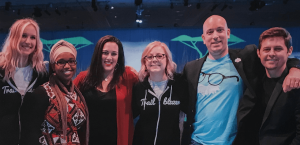Natural language processing (NLP) is transforming many disciplines – including customer service, as voice assistants and chatbots learn how to better understand human language. NLP is already being used for everything from answering customer inquiries to analyzing consumer sentiment during service calls, and innovations such as named entity recognition (NER) are set to have an even greater impact.
At Salesforce, our research and engineering teams have been researching how NER and other next-generation artificial intelligence (AI) technologies can be used to help companies and customers communicate more easily.
In fact, in our June (summer) release, all our Einstein Vision & Language customers will be getting access to Einstein NER. To understand what that means and how customers can best deploy Einstein NER, we sat down with Zineb Laraki, product lead for Einstein Vision and Language to learn more.
What is Named Entity Recognition and how does it work?
Communication is a big component of human intelligence. So, teaching computers to process and analyze the way humans naturally write or speak (once transcribed) is called Natural Language Processing, or NLP.
When humans communicate using spoken or written language, we’re doing many “tasks,” even though we may not realize it. For example, we may be analyzing for sentiment, or understanding if someone is asking a question, or judging what the intent is of what someone writes or says.
To program computers to understand natural language, we need to break down communication into these tasks. One task is understanding the sentiment of a piece of text. NER is another task.
You can think of NER as categorizing words. It’s similar to how we’re taught as children to categorize words as nouns, adjectives, or verbs. NER allows you to identify words in pre-defined categories such as Name, Organization, Date, Phone Number, and Website Address.
As humans we subconsciously do this to allow us to understand each other when we communicate. If someone says “I met with ACME Corp” or “I met with Jesse,” you understand from the first sentence that they met with a company, and from the second that they met with a person. That is because you can categorize “ACME Corp” as an entity that fits in the category “Organization”, and “Jesse” as a word that fits in the category “Name.”
How has NER enhanced Einstein Voice Assistant and Einstein Bots?
Einstein Voice Assistant and Einstein Bots use Einstein NER to understand when to update a field.
Let’s say a sales rep is using Einstein Voice Assistant and says “Update the deal size to $500,000.” Einstein Voice Assistant uses NER to understand that “$500,000” is a “Money” entity, so the “Deal Amount” field needs to be changed to “$500,000.”
Similarly, if someone sends a chat message that says “Please change my shipping address to 9 Cloud St, Cumulonimbus, CA 90260,” Einstein Bots uses NER to understand that “9 Cloud St, Cumulonimbus, CA 90260” is a “Location” entity and to update the “Delivery Address” field accordingly.
This helps to automate workflows and streamline customers’ experiences.
What makes Salesforce uniquely well placed to be delivering NER solutions?
Our goal is not to be the best NLP engine in the world, but to be the best NLP for customer relationship management and for solving our customers’ needs. This goal is very specific. We’re focused on solving problems in a way that drives value for our customers.
We have an amazing team that is helping to bridge the gap between the latest innovations in AI and creating solutions for our customers. We are working on adjusting functionality and models so we can provide world-class Einstein solutions to our customers.
What do you think the next big advancements in text and language processing will be?
One of the biggest challenges is access to clean data that can be used to train models to understand language. From our customers’ perspectives, the next meaningful advancement in text and language processing will be the ability to train models using less data. My team spends a lot of time looking at how to address this from synthetic data augmentation to developing new algorithms. Solving this problem will allow for greater adoption as it will reduce the amount of work needed to setup or get started.
How can customers get access to Einstein NER?
Einstein NER is the latest addition to the Einstein Vision & Language services. It will be generally available in June, our summer release. Einstein Language – NER, like Einstein Intent and Einstein Sentiment, are available for developers through simple REST APIs (documentation here) as well as for admis via clicks using the AppExchange package available here.
The amazing thing is that we also make the technology available for our Salesforce customers to use directly. In the same way as the Salesforce Mobile team or Salesforce Service Cloud team build applications using NER, our customers can use it to streamline or automate their custom workflows or user experiences.
Some custom use cases I have seen our customers be most excited about is being able to automate a month’s worth of survey results in just a few seconds, automatically parsing of resumes or analyze service cases just to name a few. And I can’t wait to see what awesome new use cases our customers come up with!





